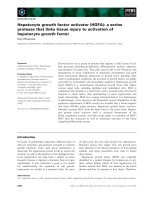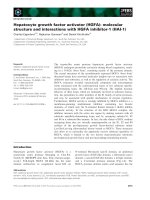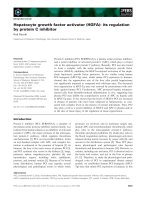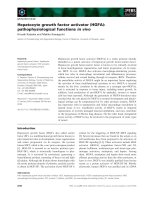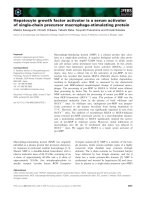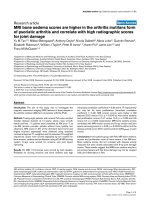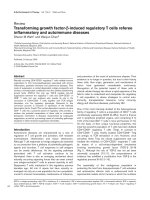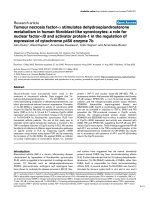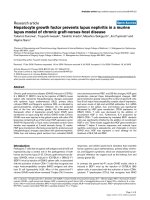Báo cáo y học: " Hepatocyte growth factor prevents lupus nephritis in a murine lupus model of chronic graft-versus-host disease" ppt
Bạn đang xem bản rút gọn của tài liệu. Xem và tải ngay bản đầy đủ của tài liệu tại đây (1.02 MB, 9 trang )
Open Access
Available online />Page 1 of 9
(page number not for citation purposes)
Vol 8 No 4
Research article
Hepatocyte growth factor prevents lupus nephritis in a murine
lupus model of chronic graft-versus-host disease
Takanori Kuroiwa
1
, Tsuyoshi Iwasaki
1
, Takehito Imado
2
, Masahiro Sekiguchi
1
, Jiro Fujimoto
3
and
Hajime Sano
1
1
Division of Rheumatology and Clinical Immunology, Department of Internal Medicine, Hyogo College of Medicine, 1-1 Mukogawa-cho, Nishinomiya,
Hyogo 663-8501, Japan
2
Division of Hematology, Department of Internal Medicine, Hyogo College of Medicine, 1-1 Mukogawa-cho, Nishinomiya, Hyogo 663-8501, Japan
3
First Department of Surgery, Hyogo College of Medicine, 1-1 Mukogawa-cho, Nishinomiya, Hyogo 663-8501, Japan
Corresponding author: Tsuyoshi Iwasaki,
Received: 17 Apr 2006 Revisions requested: 14 Jun 2006 Revisions received: 6 Jul 2006 Accepted: 14 Jul 2006 Published: 19 Jul 2006
Arthritis Research & Therapy 2006, 8:R123 (doi:10.1186/ar2012)
This article is online at: />© 2006 Kuroiwa et al.; licensee BioMed Central Ltd.
This is an open access article distributed under the terms of the Creative Commons Attribution License ( />),
which permits unrestricted use, distribution, and reproduction in any medium, provided the original work is properly cited.
Abstract
Chronic graft-versus-host disease (GVHD) induced in (C57BL/
6 × DBA/2) F1 (BDF1) mice by the injection of DBA/2 mouse
spleen cells represents histopathological changes associated
with systemic lupus erythematosus (SLE), primary biliary
cirrhosis (PBC) and Sjogren's syndrome (SS), as indicated by
glomerulonephritis, lymphocyte infiltration into the periportal
area of the liver and salivary glands. We determined the
therapeutic effect of hepatocyte growth factor (HGF) gene
transfection on lupus using this chronic GVHD model. Chronic
GVHD mice were injected in the gluteal muscle with either HVJ
liposomes containing 8 μg of the human HGF expression vector
(HGF-HVJ liposomes) or mock vector (untreated control). Gene
transfer was repeated at 2-week intervals during 12 weeks.
HGF gene transfection effectively prevented the proteinuria and
histopathological changes associated with glomerulonephritis.
While liver and salivary gland sections from untreated GVHD
mice showed prominent PBC- and SS-like changes, HGF gene
transfection reduced these histopathological changes. HGF
gene transfection greatly reduced the number of splenic B cells,
host B cell major histocompatibility complex class II expression,
and serum levels of IgG and anti-DNA antibodies. IL-4 mRNA
expression in the spleen, liver, and kidneys was significantly
decreased by HGF gene transfection. CD28 expression on
DBA/2 CD4+ T cells was decreased by the addition of
recombinant HGF in vitro. Furthermore, IL-4 production by
DBA/2 CD4+ T cells stimulated by irradiated BDF1 dendritic
cells was significantly inhibited by the addition of recombinant
HGF in vitro. These results suggest that HGF gene transfection
inhibited T helper 2 immune responses and reduced lupus
nephritis, autoimmune sialoadenitis, and cholangitis in chronic
GVHD mice. HGF may represent a novel strategy for the
treatment of SLE, SS and PBC.
Introduction
Pathogenic T cells that recognize self-antigens and drive B cell
hyperactivity play a central role in the pathogenesis of both
human and murine lupus [1-3]. Chronic graft-versus-host dis-
ease (GVHD), which is induced in (C57BL/6 × DBA/2) F1
(BDF1) mice by injection of DBA/2 spleen cells, is associated
with the activation of donor CD4+ T cells that recognize host
major histocompatibility complex (MHC) antigens and drive
host B cell hyperactivity [4,5]. Mice of this parent-into-F1
chronic GVHD model show increased T helper (Th) 2 immune
responses, and exhibit autoimmune disorders that resemble
human systemic lupus erythematosus, primary biliary chirrho-
sis, and Sjogren's syndrome, which are characterized by lym-
phocyte infiltration into organs such as the kidneys, liver and
salivary glands [6].
In contrast, the parent-into-F1 acute GVHD model, which is
induced in BDF1 mice by the injection of C57BL/6 (B6)
spleen cells, is associated with the activation of donor CD8+
cytotoxic T lymphocytes (CTLs) that recognize host MHC
CTL = cytotoxic T lymphocyte; DC = dendritic cell; ELISA = enzyme-linked immunosorbent assay; E/T – effector:target; FITC = fluorescein isothio-
cyanate; GVHD = graft-versus-host disease; HGF = hepatocyte growth factor; HVJ = hemagglutinating virus of Japan; IFN = interferon; IL = inter-
leukin; mAb = monoclonal antibodies; MHC = major histocompatibility complex; MLR = mixed lymphocyte reaction; PBS = phosphate-buffered saline;
RT-PCR = reverse transcribed PCR; SD = standard deviation; Th = T helper.
Arthritis Research & Therapy Vol 8 No 4 Kuroiwa et al.
Page 2 of 9
(page number not for citation purposes)
antigens and cause death by affecting host immune and
hematopoietic systems [7-9]. As acute GVHD can be inhibited
by the addition of neutralizing anti-IL-2 monoclonal antibodies
(mAbs) and is not induced by perforin-deficient donor T cells
[10,11], acute GVHD is associated with increased Th1-medi-
ated immune responses and with perforin expression on donor
T cells.
One of the principal distinctions between the acute and
chronic GVHD models appears to be the nine-fold reduction
in CTL precursor numbers with anti-host specificity (which
eliminate autoreactive host B cells) generated during GVHD
induced by DBA/2 mouse spleen cells rather than by B6
mouse spleen cells [12]. Previous experiments have demon-
strated that cytokines such as IL-12 and IL-18 induce donor
anti-host CTLs in chronic GVHD mice and can ameliorate
chronic GVHD, or even stimulate the development of acute
GVHD [13,14].
Recently, we demonstrated that repeated transfection of skel-
etal muscle with the gene encoding the human hepatocyte
growth factor (HGF) induced continuous production of HGF,
which strongly inhibited both acute and chronic GVHD in
bone marrow transplantation model mice. HGF gene transfec-
tion inhibited end-organ damage caused by acute GVHD
through HGF's anti-apoptotic and regenerative actions. HGF
also exerted a potent protective effect on thymus, which in turn
inhibited the development of autoreactive T cells in the thymus
damaged by acute GVHD [15,16]. Considering these results,
HGF seems to not only inhibit end-organ damage through its
anti-apoptotic and regenerative actions but also directly con-
trol autoimmunity in chronic GVHD mice. In the present study,
we evaluated the therapeutic and preventive effects of HGF
treatment using the parent-into-F1 chronic GVHD mouse
model. Our results indicate that HGF gene transfection effec-
tively prevented proteinuria and lymphocyte infiltration of the
kidneys, liver, and salivary glands. HGF gene transfection also
inhibited an increase in splenic B cell numbers, MHC class II
expression by host B cells, and serum IgG and anti-DNA anti-
body concentrations in chronic GVHD mice. Lastly, HGF
transfection inhibited IL-4 mRNA expression in the kidneys,
liver, and spleen of chronic GVHD mice. Therefore, HGF may
represent a novel strategy for the treatment of systemic lupus
erythematosus, primary biliary cirrhosis, and Sjogren's
syndrome.
Materials and methods
Animals
Female B6 (H-2
b
), DBA/2 (H-2
d
), and BDF1 (H-2
bxd
) mice at
8 to 12 weeks old were purchased from the Shizuoka Labora-
tory Animal Center (Shizuoka, Japan). All mice were main-
tained in a pathogen-free facility at the Hyogo College of
Medicine. Animal experiments were done in accordance with
the guidelines of the National Institutes of Health, as specified
by the animal care policy of Hyogo College of Medicine.
Induction of GVHD
DBA/2 mouse spleen cells (9 × 10
7
) or B6 mouse spleen cells
(5 × 10
7
) were injected into non-irradiated BDF1 mice via the
tail vein as previously described [7-9]. Control mice were
injected with normal BDF1 mouse spleen cells (9 × 10
7
).
Expression vector and preparation of liposomes
containing hemagglutinating virus of Japan
Human HGF cDNA (2.2 kb) was inserted into the EcoRI and
NotI sites in the pUC-SRα plasmid under the control of the
SRα promoter [17]. Hemagglutinating virus of Japan (HVJ)
liposomes containing plasmid DNA and high mobility group 1
protein were constructed as previously described [15]. Briefly,
phosphatidylserine, phosphatidylcholine, and cholesterol were
mixed at a ratio of 1:4.8:2 (w/w/w), and 1 mg of this lipid mix-
ture added to 20 to 40 μg of plasmid DNA that had been com-
plexed with 6 to 12 μg high mobility group 1 nonhistone
chromosomal protein purified from calf thymus. This mixture
was sonicated to form liposomes and then mixed with ultravi-
olet-irradiated HVJ. Excess free virus was then removed from
the HVJ liposomes by sucrose density gradient centrifugation.
Gene transfer
BDF1 mice were injected with either HVJ liposomes contain-
ing 8 μg human HGF expression vector (HGF-HVJ liposomes)
or mock vector (GVHD control) into the gluteal muscle. Gene
transfer was repeated at 2-week intervals from the first day of
GVHD induction for 12 weeks.
Histopathology
Tissues were fixed in 10% buffered formalin and embedded in
paraffin. Sections were stained with hematoxylin and eosin
and examined by light microscopy.
Flow cytometry
Cell suspensions were prepared in PBS containing 1% fetal
calf serum and 0.1% (W/V) sodium azide. Cells were incu-
bated with anti-Fc receptor mAb (2.4G2) for 10 minutes at
4°C, and then incubated with FITC-conjugated mAb and phy-
coerythrin-conjugated mAb for 30 minutes. Stained cells were
washed twice, resuspended, and analyzed using a FACScan
(Becton Dickinson, Mountain View, California, USA). Anti-Fc
receptor (2.4G2) mAb, FITC-conjugated anti-mouse H-2K
b
(clone AF6-88.5) mAb, anti-B220 (clone RA3-6B2) mAb, anti-
CD80 (B7-1) (clone 1G10) mAb, anti-CD86 (B7-2) (clone
GL1) mAb, anti-CD28 (clone 37.51), and phycoerythrin-con-
jugated anti-mouse H-2K
d
(clone SF1-1.1) mAb, and anti-I-A
b
mAb (clone AF6-120.1) were all purchased from PharMingen
(SanDiego, California, USA). Multicolor flow cytometry was
performed as described previously, with some modifications
[15,16]. Channel numbers for data integration were chosen
according to the staining patterns of normal spleen cells.
Staining of normal F1 spleen cells with anti-MHC antibodies
gave a unimodal positive profile when compared to negative
controls. Donor cells in GVHD mice were identified as
Available online />Page 3 of 9
(page number not for citation purposes)
subpopulations that were clearly negative for F1-specific
MHC markers.
ELISA for IL-4 and IFN-γ
Murine IL-4 and IFN-γ levels in culture supernatants were
measured by ELISA using anti-mouse IL-4 and IFN-γ mAb
(Genzyme Pharmaceuticals, Cambridge, Massachusetts,
USA) according to the manufacturer's protocols.
Urine protein measurement
Proteinuria was assessed semiquantitatively using urine dip
sticks (Albustix; Bayer Diagnostics, Basingstoke, United
Kingdom).
Measurement of serum IgG1 and anti-ssDNA antibodies
Sera were collected from individual mice and serum levels of
IgG1 and anti-single-stranded (ss)DNA antibodies determined
by ELISA. Briefly, purified rat anti-mouse IgG1 mAb (A85-3;
PharMingen) and HRP-conjugated rat anti-mouse IgG1
(Zymed, San Francisco, California, USA) were used for plate
coating and secondary Abs, respectively, with mouse IgG1
(S1-68.1; PharMingen) used as the protein standard. Serum
levels of anti-ssDNA IgG were determined by ELISA as
described previously [18]. Briefly, microtiter plates were
coated with heat-denatured calf thymus DNA (Sigma, St
Louis, Missouri, USA), blocked with 2% BSA-PBS, and incu-
bated with two-fold serial dilutions of experimental mouse sera
beginning at a dilution of 1/50. Plates were then incubated
with HRP-labeled anti-mouse IgG (Zymed) and OD measured
at 405 nm.
Mixed lymphocyte reaction and in vitro cytokine
production
CD4+ T cells and CD11c+ dendritic cells (DCs) were purified
from spleen cells by positive selection using immunomagnetic
beads (Miltenyi Biotec, Auburn, California, USA). Purity of the
CD4+ and CD11c+ populations was >90% and >95%,
respectively. CD4+ T cells from DBA/2 (H-2
d
) mice (4 × 10
6
/
ml/well) were cultured with irradiated (20 Gy) CD11c+ DCs
from BDF1 (H-2
b×d
) mice (1 × 10
6
/ml/well) in 24-well flat-bot-
tomed plates (Falcon Labware, Lincoln Park, New Jersey,
USA). After 72 h, viable cells (1 × 10
5
/200 μl/well) were stim-
ulated in 96-well flat-bottomed plates (Falcon Labware)
coated with 5 μg/ml anti-CD3 mAb (PharMingen). After 48 h,
IL-4 and IFN-γ concentrations in the culture supernatants were
measured by ELISA.
51
Cr release assay
Anti-host CTL activity was tested using spleen cells from
chronic GVHD mice at 2 weeks after GVHD induction. Spleen
cells (5 × 10
6
/ml/well) were restimulated with irradiated (20
Gy) BDF1 spleen cells (3 × 10
6
/ml/well) for 5 days. Effector
cells were harvested and CTL activity assessed based on the
lysis of EL-4 (H-2
b
) cells in a 4 h
51
Cr release assay. Anti-host
CTL activity was also tested using spleen cells from acute
GVHD mice based on P815 cell (H-2
d
) lysis. Effector cells
were tested in triplicate at four effector:target ratios and the
percent lysis calculated according to the following formula:
[(sample cpm - spontaneous cpm)/(maximum cpm - spontane-
ous cpm)] × 100%. Results were calculated as the mean per-
cent lysis ± standard deviation at a given effector:target ratio
for each treatment group.
Reverse transcribed PCR
RNA was extracted using an ISOGEN (Nippongene, Toyama,
Japan) according to the manufacturer's instructions, and
cDNA prepared using 2.5 μM random hexamers (Applied Bio-
systems Inc., Foster City, California, USA). IFN-γ and IL-4
mRNA levels were quantified by real-time reverse transcribed
(RT)-PCR in a total volume of 25 μL for 40 to 50 cycles of 15
s at 95°C and 1 minute at 60°C. Samples were run in triplicate,
and relative expression levels determined by normalizing
expression according to β-actin expression. Primer sequences
used were: IFN-γ, TGGCTGTTTCTGGCTGTTACTG and
AATCAGCAGCGACTCCTTTTCC; IL-4, CCAGCTAGTTGT-
CATCCTGCTCTTCTTTCTCG and CAGTGATGAGGACTT-
GGACTCATTCATGGTGC; β-actin,
TGTGATGGTGGGAATGGGTCAG and
TTTGATGTCACGCACGATTTCC.
Statistical analysis
Group mean values were compared using the two-tailed Stu-
dent's t-test. A p value of less than 0.05 was considered sta-
tistically significant.
Results
HGF reduces histopathological changes caused by
chronic GVHD
We investigated whether HGF gene transfection could pre-
vent murine lupus in a model of chronic GVHD using non-irra-
diated parent spleen cells injected into F1 recipient mice.
Increased proteinuria was observed in untreated chronic
GVHD mice at 6 weeks after GVHD induction and, by 12
weeks, 6 of 10 chronic GVHD mice had features consistent
with nephritic syndrome. Light microscopy analysis of kidney
tissues revealed mononuclear cell infiltration into the perivas-
cular area at 3 weeks and glomerulonephritis, as shown by
glomerular enlargement, increased glomerular lobularity,
mesangial hypercellularity, and increased membrane thick-
ness, at 12 weeks. Repeated transfection of the human HGF
gene into skeletal muscle of chronic GVHD mice achieved a
plasma HGF level (human and mouse HGF) between 1.07
and 1.35 ng/ml during the 12 week period after GVHD induc-
tion. HGF gene transfection significantly inhibited proteinuria
(Figure 1a) and histopathological changes associated with
chronic GVHD (Figure 1b). HGF treatment also inhibited
mononuclear cell infiltration into the liver and salivary glands of
chronic GVHD mice (Figure 2).
Arthritis Research & Therapy Vol 8 No 4 Kuroiwa et al.
Page 4 of 9
(page number not for citation purposes)
HGF reduces splenic B cell numbers and serum IgG1 and
anti-DNA antibody concentrations in chronic GVHD mice
The number of host B cells decreased by 35% in HGF gene
transfected chronic GVHD mice compared to untreated
chronic GVHD mice (Figure 3a). Furthermore, serum IgG1
and anti-ssDNA antibody concentrations were significantly
decreased by HGF gene transfection (Figure 3b,c). Several
investigators have previously shown that treatment with IL-12
or IL-18 induced donor anti-host CTLs that eliminated host B
cells in chronic GVHD mice [13,14]. Therefore, we investi-
gated whether HGF gene transfection induced donor anti-
host CTLs in our chronic GVHD mouse model. To examine
donor anti-host CTLs, spleen cells harvested 14 days after
GVHD induction were stimulated with 20 Gy irradiated BDF1
spleen cells for 5 days, and then the cytotoxic activity of the
cultured cells analyzed using
51
Cr-labeled EL-4 (H-2
b
) or
P815 (H-2
d
) as target cells. While spleen cells from both
untreated and HGF-treated chronic GVHD mice showed no
specific CTL activity toward host-type EL-4 cells (Figure 3d),
spleen cells from acute GVHD mice showed CTL activity
against host-type P815 cells (data not shown). This result indi-
cated that HGF gene transfection did not appear to induce
donor anti-host CTLs, which might explain the elimination of
activated host B cells in treated chronic GVHD mice.
HGF reduces IL-4 mRNA expression in target organs of
chronic GVHD
Injection of DBA/2 spleen cells into BDF1 mice resulted in
Th2 activation, as shown by the elevated IL-4 mRNA levels in
target organs of mice with chronic GVHD [19,20]. Chronic
GVHD is inhibited by the injection of anti-IL-4 mAb, which sug-
gests a critical role for IL-4 in this disease [21,22]. We exam-
ined the effect of HGF gene transfection on IL-4 and IFN-γ
mRNA expression levels in target chronic GVHD organs in the
mouse. Expression of both IL-4 and IFN-γ mRNA was
increased in the kidneys, liver, and spleen of untreated chronic
GVHD mice 2 weeks after GVHD induction. HGF gene trans-
fection significantly inhibited the expression of IL-4 mRNA in
these organs, while IFN-γ mRNA expression levels were not
significantly altered between HGF-treated and untreated
chronic GVHD mice (Figure 4).
HGF reduces MHC class II expression on host B cells
Chronic GVHD requires continuous donor CD4+ T cell activa-
tion through recognition of host MHC class II antigens. This
results in the secretion of predominantly Th2 cytokines and the
stimulation of autoreactive B cells that differentiate into
autoantibody-secreting cells [4-6]. It is possible that HGF may
decrease the expression of MHC class II antigens on host B
cells, which would suppress donor CD4+ T cell activation, and
so reduce the Th2 response in chronic GVHD mice. Therefore,
we examined the effect of HGF on host B cell MHC class II
expression in our chronic GVHD mouse model. While
untreated chronic GVHD mice expressed high levels of MHC
class II antigens on host B cells, host B cells from HGF-treated
chronic GVHD mice showed reduced expression (Figure 5a).
To determine whether this reduced B cell MHC class II expres-
sion was a direct effect of HGF, we examined the effect of
HGF on IL-4-induced MHC class II expression by B cells in
vitro. BDF1 B cells were cultured in the presence of IL-4 with
or without HGF, and MHC class II expression examined after
Figure 1
Therapeutic effects of hepatocyte growth factor (HGF) on the progres-sion of lupus nephritisTherapeutic effects of hepatocyte growth factor (HGF) on the progres-
sion of lupus nephritis. (a) Protective effect of HGF against the devel-
opment of nephritic syndrome, as determined by changes in urine
protein excretion levels. Open circles, HGF-treated graft-versus-host
disease (GVHD; n = 10); closed circles, untreated GVHD (n = 10).
Data represent mean ± standard error (n = 10). *p < 0.05; **p < 0.01
compared to untreated GVHD at the same time point. (b) Histopathol-
ogy of kidney tissue from untreated and HGF-treated GVHD mice.
Mononuclear cell infiltration into the perivascular area of the kidney was
observed at 3 weeks, and glomerulonephritis, as shown by glomerular
enlargement, increased glomerular lobularity, mesangial hypercellular-
ity, and membrane thickening was observed at 12 weeks after GVHD
induction. HGF treatment significantly inhibited these pathological
changes. Original magnification ×200.
Available online />Page 5 of 9
(page number not for citation purposes)
2 days of culture. Addition of HGF did not affect B cell MHC
class II expression (Figure 5b). Another possibility is that donor
DBA/2 CD4+ T cells differentiate into Th2 in response to host
MHC antigens and induce MHC class II expression on host B
cells in chronic GVHD mice. Therefore, we examined the abil-
ity of cultured DBA/2 anti-BDF1 MLR cells to induce MHC
class II expression on BDF1 B cells. DBA/2 CD4+ T cells
were cultured with 20 Gy irradiated BDF1 DCs in the pres-
Figure 2
Inhibitory effect of hepatocyte growth factor (HGF) on mononuclear infiltration in the liver and the salivary glandsInhibitory effect of hepatocyte growth factor (HGF) on mononuclear infiltration in the liver and the salivary glands. Chronic graft-versus-host disease
(GVHD) mice were treated as described in Figure 1, and histopathology of the liver and salivary glands examined 12 weeks after GVHD induction.
HGF treatment inhibited mononuclear cell infiltration into the liver and salivary glands of chronic GVHD mice. Original magnification ×200.
Figure 3
Effect of hepatocyte growth factor (HGF) on host B cell activation and donor anti-host cytotoxic T lymphocyte (CTL) activityEffect of hepatocyte growth factor (HGF) on host B cell activation and donor anti-host cytotoxic T lymphocyte (CTL) activity. Chronic graft-versus-
host disease (GVHD) mice were treated as described in Figure 1. (a) At 2 weeks after GVHD induction, spleens were removed and H-2K
b
+B220+
cells examined by flow cytometry. Data represent mean ± SD for four mice per group. (b) At 2 weeks after GVHD induction, serum IgG1 concentra-
tions were determined by ELISA. Data represent mean ± SD for four mice per group. (c) At 2 weeks after GVHD induction, serum anti-single-
stranded DNA antibody concentrations were determined by ELISA. Data represent mean ± SD for four mice per group. (d) At 2 weeks after GVHD
induction, spleen cells were stimulated with irradiated BDF1 spleen cells for 5 days. Cytotoxicity was determined by CTL activity against
51
Cr-
labeled EL-4 (H-2
b
) target cells. CTL activity against P815 cells (H-2
d
) by acute GVHD mouse spleen cells was used as a positive control. Effector
cells were tested in triplicate at four effector:target (E/T) ratios and the percent lysis calculated. Data represent mean ± SD for four mice per group.
Arthritis Research & Therapy Vol 8 No 4 Kuroiwa et al.
Page 6 of 9
(page number not for citation purposes)
ence or absence of HGF for 3 days, after which viable cells
were cultured with BDF1 B cells and MHC class II expression
assessed. While MHC class II expression by BDF1 B cells
was significantly increased in the presence of viable MLR cells
in the absence of HGF, expression levels were not increased
in the presence HGF (Figure 5b). Thus, our results indicated
that HGF may inhibit the ability of donor DBA/2 T cells to
induce MHC class II expression by host BDF1 B cells in
chronic GVHD mice.
In vitro treatment with HGF reduces Th2 generation from
DBA/2 CD4+ T cells
As donor DBA/2 CD4+ T cells differentiate into Th2 cells in
response to host BDF1 antigen presenting cells in chronic
Figure 4
Effect of hepatocyte growth factor (HGF) on cytokine gene expression by chronic graft-versus-host disease (GVHD) miceEffect of hepatocyte growth factor (HGF) on cytokine gene expression by chronic graft-versus-host disease (GVHD) mice. Chronic GVHD mice
were treated as described in Figure 1. At 2 weeks after GVHD induction, spleen, liver, and kidneys were removed and IFN-γ and IL-4 mRNA expres-
sion determined by RT-PCR analysis. Data represent mean ± SD for four mice per group. *p < 0.05 compared to untreated GVHD.
Figure 5
Effect of hepatocyte growth factor (HGF) on B cell MHC class II expressionEffect of hepatocyte growth factor (HGF) on B cell MHC class II expression. (a) Chronic graft-versus-host disease (GVHD) mice were treated as
described in Figure 1. At 2 weeks after GVHD induction, spleens were removed and the mean fluorescence intensity of MHC class II (I-A
b
) expres-
sion on B220+ cells determined. Data represent mean ± SD for four mice per group. *p < 0.05. (b) B220+ cells from BDF1 mice (2 × 10
6
/ml) were
cultured with mouse recombinant IL-4 (10 ng/ml) in the presence or absence of human recombinant HGF (10 ng/ml) for 48 h, and mean fluores-
cence intensity of MHC class II (I-A
b
) expression on B220+ cells determined. Data represent mean ± SD of three independent experiments. *p <
0.05. (c) CD4+ T cells from DBA/2 (H-2
d
) mice (4 × 10
6
/ml/well) were cultured with irradiated (20 Gy) CD11c+ dendritic cell (DCs) from BDF1 (H-
2
b×d
) mice (1 × 10
6
/ml/well) in the presence or absence of human recombinant HGF (10 ng/ml). After 72 h, viable cells (1 × 10
6
/ml) were cultured
with B220+ cells from BDF1 mice (2 × 10
6
/ml) for 48 h and mean fluorescence intensity of MHC class II (I-A
b
) expression on B220+ cells deter-
mined. Data represent mean ± SD of three independent experiments. *p < 0.05.
Available online />Page 7 of 9
(page number not for citation purposes)
GVHD mice, we performed a DBA/2 anti-BDF1 MLR and
examined the effect of HGF on the generation of Th1 and Th2.
Responder CD4+ T cells from DBA/2 mice were cultured with
20 Gy irradiated CD11c+ DCs from BDF1 mice with or with-
out HGF. After 3 days culture, viable cells were stimulated by
culture with anti-CD3 mAb for 48 h, and IL-4 and IFN-γ levels
in the culture supernatant assayed by ELISA. While both IL-4
and IFN-γ production was inhibited by HGF, the inhibitory
effect of HGF was greater on IL-4 production than on IFN-γ
production (Figure 6). This suggested that HGF inhibited Th2
generation from DBA/2 CD4+ T cells stimulated by BDF1
DCs.
In vitro treatment with HGF down-regulates CD28
expression on CD4+ T cells
To investigate mechanisms of HGF to reduce Th2 generation
from DBA/2 CD4+ T cells, we examined the effect of HGF on
costimulatory molecules on CD4+ T cells and DCs. Previous
studies have shown that the development of Th2 responses
depends on CD86 interaction with CD28 [23,24]. We exam-
ined the effect of recombinant HGF on CD28 expression on
CD4+ T cells and CD86 expression on CD11c+ DCs. DBA/
2 or B6 CD4+ T cells were cultured in the presence or
absence of recombinant HGF, and CD28 expression on
CD4+ T cells was examined. Addition of HGF down-regulated
CD28 expression on DBA/2 CD4+ T cells but not on B6
CD4+ T cells (Figure 7a). We next performed a DBA/2 or B6
anti-BDF1 MLR for 48 h and examined the effect of recom-
binant HGF on CD28 expression on CD4+ T cells. CD28
expression on CD4+ T cells from both DBA/2 and B6 mice
was down-regulated by the addition of recombinant HGF, but
this down-regulating activity of HGF was stronger in DBA/2
CD4+ T cells than in B6 CD4+ T cells (Figure 7b). CD86
expression on BDF1 DCs cultured with DBA/2 CD4+ T cells
was also down-regulated by the addition of recombinant HGF
(Figure 7c). These results suggest that down-regulation of
CD86 interaction with CD28 by HGF inhibits subsequent Th2
differentiation of DBA/2 CD4+ T cells.
Discussion
The present study demonstrates that repeated HGF gene
transfection into BDF1 mice prevents the development of
chronic GVHD induced by the injection of DBA/2 spleen cells.
HGF transfection significantly inhibited proteinuria and his-
topathological changes of the kidneys, liver and salivary glands
caused by chronic GVHD.
The parent-to-F1 murine model of chronic GVHD exhibits Th2-
mediated immune responses, such as polyclonal B cell
activation, autoantibody formation, and decreased CTL
responses, that closely resemble lupus-like autoimmune dis-
ease. Rus and colleagues [5] reported that Th2 cytokine
secretion and B cell activation may be early events in both
Figure 6
In vitro effect of hepatocyte growth factor (HGF) on T helper (Th)2 gen-eration from DBA/2 CD4+ T cellsIn vitro effect of hepatocyte growth factor (HGF) on T helper (Th)2 gen-
eration from DBA/2 CD4+ T cells. CD4+ T cells from DBA/2 (H-2
d
)
mice (4 × 10
6
/ml/well) were cultured with irradiated (20 Gy) CD11c+
dendritic cell (DCs) from BDF1 (H-2
b×d
) mice (1 × 10
6
/ml/well) in the
presence or absence of human recombinant HGF (10 ng/ml). CD4+ T
cells from DBA/2 (H-2
d
) mice (4 × 10
6
/ml/well) cultured without
CD11c+ DC stimulation were used as controls. After 72 h, viable cells
(1 × 10
5
/200 μl/well) were harvested and stimulated with anti-CD3
mAb (5 μg/ml) for 48 h. The concentration of IL-4 (a) and IFN-γ (b) in
the culture supernatant was measured by ELISA. Data represent mean
± SD of three independent experiments. *p < 0.05; **p < 0.01.
Figure 7
Effect of hepatocyte growth factor (HGF) on CD4+ T cell CD28 expression and on CD11c+ dendritic cell (DC) CD86 expressionEffect of hepatocyte growth factor (HGF) on CD4+ T cell CD28
expression and on CD11c+ dendritic cell (DC) CD86 expression. (a)
CD4+ T cells from DBA/2 (H-2
d
) or B6 (H-2
b
) mice (4 × 10
6
/ml/well)
were cultured in the presence or absence of human recombinant HGF
(10 ng/ml). After 48 h, mean fluorescence intensity of CD28 expression
on CD4+ T cells determined. Data represent mean ± SD of three inde-
pendent experiments. *p < 0.05. (b,c) CD4+ T cells from DBA/2 (H-2
d
)
or B6 (H-2
b
) mice (4 × 10
6
/ml/well) were cultured with irradiated (20
Gy) CD11c+ DCs from BDF1 (H-2
b×d
) mice (1 × 10
6
/ml/well) in the
presence or absence of human recombinant HGF (10 ng/ml) for 48 h,
and mean fluorescence intensity of CD28 expression on CD4+ T cells
(b) and CD86 expression on CD11c+ DCs (c) determined. Data repre-
sent mean ± SD of three independent experiments. *p < 0.05; **p <
0.01.
Arthritis Research & Therapy Vol 8 No 4 Kuroiwa et al.
Page 8 of 9
(page number not for citation purposes)
acute and chronic GVHD. It is thought that the transition to
chronic GVHD involves the failure of CD8+ anti-host CTLs to
kill activated host B cells [5]. In this context, therapeutic
strategies tested in chronic GVHD mice have included the use
of Th1-inducing cytokines [13,14]. Early treatment with IL-12
(on days 0 to 4 after induction of chronic GVHD) but not late
treatment (on days 8 to 12 after induction of chronic GVHD)
generated anti-host CTLs that eliminated host autoantibody-
producing B cells, thereby converting chronic GVHD into
acute GVHD [13]. However, regardless of treatment schedule
(treatment on days 0 to 5 or days 8 to 13 after induction of
chronic GVHD), IL-18 treatment generated anti-host CTLs,
but did not induce acute GVHD [14].
In contrast to Th1-inducing cytokine treatment, HGF did not
generate anti-host CTLs in vivo. Although Th1-inducing
cytokines induced the development of DBA/2-derived Th1 in
a DBA/2 anti-BDF1 MLR [25], the addition of HGF did not
induce Th1 in vitro (data not shown). However, HGF treatment
inhibited IL-4 mRNA expression in chronic GVHD target
organs, splenic B cell expansion, and autoantibody production
in chronic GVHD mice. Thus, it appears that HGF inhibited
lupus-like autoimmune disease through the inhibition of Th2
generation rather than by induction of Th1.
The precise mechanisms by which HGF inhibits Th2-mediated
responses in chronic GVHD mice remain unclear. Possible
mechanisms include that HGF suppresses MHC class II
expression by host B cells, leading to reduced antigen
presentation to donor CD4+ T cells. Indeed, we observed
decreased MHC class II expression on host B cells from HGF-
treated chronic GVHD mice. While the addition of HGF to an
in vitro DBA/2 anti-BDF1 MLR inhibited the capacity of BDF1
B cells to increase MHC class II expression, HGF did not
inhibit IL-4-induced B cell MHC class II expression, which sug-
gested that HGF did not directly suppress MHC class II
expression on host B cells.
DCs play a pivotal role in determining the balance between
responsiveness and tolerance in the immune system [26,27],
and the persistence of host DCs following bone marrow trans-
plantation is correlated with the development of severe acute
and chronic GVHD [28,29]. Chronic DC activation, such as by
CD40L over-expression in basal epidermal layers that acceler-
ates DC maturation, leads to autoimmunity [30]. Immature
myeloid DCs are loaded with self-antigen-derived molecules
and, upon interaction with T cells, deliver a signal that results
in T cell deletion and anergy [31]. Modified myeloid DCs can
act as regulatory DCs to protect against acute GVHD [32].
We observed that in a DBA/2 anti-BDF1 MLR, which contains
DBA/2 CD4+ T cells and BDF1 DCs, the addition of HGF sig-
nificantly inhibited the generation of DBA/2 Th2. We also
observed that c-Met/HGF receptors are expressed by both
DCs and CD4+ T cells (data not shown) and that HGF signif-
icantly down-regulated CD28 expression on DBA/2 CD4+ T
cells stimulated by BDF1 DCs. We also observed down-regu-
lation of CD86 expression on BDF1 DCs cultured with DBA/
2 CD4+ T cells. HGF may act on the CD28-CD86 pathway,
thereby inhibiting Th2 generation.
We recently demonstrated that repeated transfection of the
human HGF gene into skeletal muscle in a bone marrow trans-
plantation model of GVHD promoted hematopoietic function
and strongly inhibited acute GVHD by limiting tissue damage
and the subsequent endotoxin-mediated inflammatory cas-
cade [15]. The principal mechanisms by which HGF blocks
acute GVHD appeared to involve the protection of target
organs from injury through anti-apoptotic effects and the inhi-
bition of subsequent inflammatory cytokine reactions [16]. In
the present study, we demonstrated that HGF inhibited the
increased Th2-mediated immune response in chronic GVHD
mice. Thus, HGF treatment may be beneficial for both Th1-
mediated acute GVHD and Th2-mediated autoimmune
chronic GVHD.
Conclusion
HGF gene transfection effectively prevented the proteinuria
and histopathological changes associated with glomerulone-
phritis, primary biliary cirrhosis and Sjogren's syndrome. HGF
gene transfection greatly reduced the number of splenic B
cells, host B cell MHC class II expression, and serum levels of
IgG and anti-DNA antibodies. IL-4 mRNA expression in the
spleen, liver, and kidneys was significantly decreased by HGF
gene transfection. CD28 expression on DBA/2 CD4+ T cells
and CD86 expression on BDF1 DCs was decreased by the
addition of recombinant HGF in vitro. Furthermore, IL-4 pro-
duction by DBA/2 CD4+ T cells stimulated by irradiated BDF1
DCs was significantly inhibited by the addition of recombinant
HGF in vitro. These results suggested that HGF gene trans-
fection inhibited Th2 immune responses and reduced lupus
nephritis, autoimmune sialoadenitis, and cholangitis in chronic
GVHD mice. HGF may represent a novel strategy for the treat-
ment of systemic lupus erythematosus, Sjogren's syndrome
and primary biliary cirrhosis.
Competing interests
The authors declare that they have no competing interests.
Authors' contributions
TK, TI (Takehito Imado), and MS performed the animal study.
TI (Tsuyoshi Iwasaki) conceived of the study, participated in
the design and coordination of the study, and participated in
the interpretation of the results. JF participated in the HGF
gene preparation and transfection. HS participated in the
design and interpretation of the results. Tsuyoshi Iwasaki and
Takanori Kuroiwa contributed equally to this work and should
be considered as joint first authors.
Acknowledgements
We thank Hirotsugu Kubo and Masahito Yagi for their assistance in pre-
paring this manuscript. TI acknowledges the support of Grants for Sci-
Available online />Page 9 of 9
(page number not for citation purposes)
entific Research from the Ministry of Education, Science and Culture of
Japan (No. 14657120 and No. 15591071).
References
1. Burlingame RW, Rubin RL, Balderas RS, Theofilopoulos AN: Gen-
esis and evolution of antichromatin autoantibodies in murine
lupus implicates T-dependent immunization with self antigen.
J Clin Invest 1993, 91:1687-1696.
2. Desai-Mehta A, Mao C, Rajagopalan S, Robinson T, Datta SK:
Structure and specificity of T cell receptors expressed by
potentially pathogenic anti-DNA autoantibody-inducing T cells
in human lupus. J Clin Invest 1995, 95:531-541.
3. Cohen PL, Litvin DA, Winfield JB: Association between endog-
eneously activated T cells and immunoglobulin-secreting B
cells in patients with active systemic lupus erythematosus.
Arthritis Rheum 1982, 25:168-173.
4. Gleichmann E, Pals ST, Rolink AG, Radaszkiewicz T, Gleichmann
H: Graft-versus-host reactions: clues to the etiopathology of a
spectrum of immunological diseases. Immunol Today 1984,
5:324-332.
5. Rus VA, Svetic A, Nguyen P, Gausen WC, Via CS: Kinetics of Th1
and Th2 cytokine production during the early course of acute
and chronic murine graft-versus-host disease: regulatory role
of donor CD8+ T cells. J Immunol 1995, 155:2396-2406.
6. Van Rappard-Van Der Veen FM, Radaszkiewicz T, Teraneo L,
Gleichmann E: Attempts at standardization of lupus-like graft-
vs-host disease: inadvertent repopulation by DBA/2 spleen
cells of H-2 different nonirradiated F1 mice. J Immunol 1983,
130:2693-2701.
7. Moser M, Iwasaki T, Shearer GM: Cellular interaction in graft-
versus-host-induced T cell immune deficiency. Immunol Rev
1985, 88:135-151.
8. Joseph LJ, Iwasaki T, Malek TR, Shearer GM: Interleukin 2 recep-
tor dysfunction in mice undergoing a graft-vs-host reaction. J
Immunol 1985, 135:1846-1850.
9. Iwasaki T, Fujiwara H, Iwasaki T, Shearer GM: Loss of prolifera-
tive capacity and T cell immune development potential by
bone marrow from mice undergoing a graft-vs-host reaction.
J Immunol 1986, 137:3100-3108.
10. Via CS, Finkelman FD: Critical role of interleukin-2 in the devel-
opment of acute graft-versus-host disease. Int Immunol 1993,
5:565-572.
11. Schstov A, Luzina I, Nguyen P, Papadimitriou JC, Handwerger B,
Elkon KB, Via CS: Role of perforin in controlling B-cell hyperac-
tivity and humoral autoimmunity. J Clin Invest 2000,
106:R39-47.
12. Via CS, Sharrow SO, Shearer GM: Role of cytotoxic T lym-
phocytes in the prevention of lupus-like disease occurring in a
murine model of chronic graft-vs-host disease. J Immunol
1987, 139:1840-1849.
13. Via CS, Rus V, Gately MK, Finkelman FD: IL-12 stimulates the
development of acute graft-versus-host disease in mice that
normally would develop chronic, autoimmune graft-versus-
host disease. J Immunol 1994, 153:4040-4047.
14. Okamoto I, Kohno K, Tanimoto T, Iwaki K, Ishihara T, Akamatsu S,
Ikegami H, Kurimoto M: IL-18 prevents the development of
chronic graft-versus-host disease in mice. J Immunol 2000,
164:6067-6074.
15. Kuroiwa T, Kakishita E, Hamano T, Kataoka Y, Seto Y, Iwata N,
Kaneda Y, Matsumoto K, Nakamura T, Ueki T, et al.: Hepatocyte
growth factor ameliorates acute graft-versus-host disease
and promotes hematopoietic function. J Clin Invest 2001,
107:1365-1373.
16. Imado T, Iwasaki T, Kataoka Y, Kuroiwa T, Hara H, Fujimoto J,
Sanoh H: Hepatocyte growth factor preserves graft-versus-
leukemia effect and T cell reconstitution after marrow
transplantation. Blood 2004, 104:1542-1549.
17. Morishita R, Sugimoto T, Aoki M, Kida I, Tomita N, Moriguchi A,
Maeda K, Sawa Y, Kaneda Y, Higaki J, et al.: In vivo transfection
of cis element "decoy" against nuclear factor-κB binding site
prevents myocardial infarction. Nat Med 1997, 3:894-899.
18. Rus V, Svetic A, Nguyen P, Gause WC, Via CS: Kinetics of Th1
and Th2 cytokine production during the early course of acute
and chronic murine graft-versus-host disease. Regulatory role
of donor CD8+ T cells. J Immunol 1995, 155:2396-2406.
19. De Wit D, Van Mechelen M, Zanin C, Doutrelepont JM, Velu T, Ger-
ard C, Abramowicz D, Scheerlinck JP, De Baetselier P, Urbain J, et
al.: Preferential activation of Th2 cells in chronic graft-versus-
host reaction. J Immunol 1993, 150:361-366.
20. Garlisi CG, Pennline KJ, Smith SR, Siegel MI, Umland SP:
Cytokine gene expression in mice undergoing chronic graft-
versus-host disease. Mol Immunol 1993, 30:
669-677.
21. Doutrelepont JM, Moser M, Leo O, Abramowicz D, Vanderhaegen
ML, Urbain J, Goldman M: Hyper IgE in stimulatory graft-versus-
host disease: role of interleukin-4. Clin Exp Immunol 1991,
83:133-136.
22. Umland SP, Razac S, Nakrebone DK, Seymour BW: Effect of in
vivo administration of interferon (IFN)-γ, anti-IFN-γ, or anti-
interleukin-4 monoclonal antibodies in chronic autoimmune
graft-versus-host disease. Clin Immunol Immunopathol 1992,
63:66-73.
23. Gause WC, Chen SJ, Greenwald RJ, Halvorson MJ, Lu P, Zhou
XD, Morris SC, Lee KP, June CH, Finkelman FD, et al.: CD28
dependence of T cell differentiation of IL-4 production varies
with the particular type 2 immune response. J Immunol 1997,
158:4082-4087.
24. Natesan M, Razi-Wolf Z, Reiser H: Costimulation of IL-4 produc-
tion by murine B7-1 and B7-2 molecules. J Immunol 1996,
156:2783-2791.
25. Okamoto I, Kohno K, Tanimoto T, Ikegami H, Kurimoto : Develop-
ment of CD8+ effector T cells is differentially regulated by IL18
and IL12. J Immunol 1999, 162:3202-3211.
26. Banchereau J, Briere F, Caux C, Davoust J, Lebecque S, Liu YJ,
Pulendran B, Palucka K: Immunobiology of dendritic cells. Annu
Rev Immunol 2000, 18:767-811.
27. Steinman RM, Nussenzweig MC: Avoiding horror autotoxicus:
the importance of dendritic cells in peripheral T cell tolerance.
Proc Natl Acad Sci USA 2002, 99:351-358.
28. Ferrara JL, Cooke KR, Pan L, Krenger W: The immunopatho-
physiology of acute graft-versus-host disease. Stem Cells
1996, 14:473-489.
29. Chan GW, Gorgun G, Miller KB, Foss FM: Persistence of host
dendritic cells after transplantation is associated with graft-
versus-host disease. Biol Blood Marrow Transplant 2003,
9:170-176.
30. Mehling A, Loser K, Varga G, Metze D, Luger TA, Schwartz T,
Grabbe S, Beissert S: Overexpression of CD40 ligand in murine
epidermis results in chronic skin inflammation and systemic
autoimmunity. J Exp Med 2001, 194:615-628.
31. Hawiger D, Inaba K, Dorsett Y, Guo K, Mahnke K, Rivera M,
Ravetch JV, Steinman RM, Nussenzweig MC: Dendritic cells
induce peripheral T cell unresponsiveness under steady state
conditions in vivo. J Exp Med 2001, 194:769-779.
32. Sato K, Yamashita N, Baba M, Matsuyama T: Modified myeloid
dendritic cells act as regulatory cells to induce anergic and
regulatory T cells. Blood 2003, 101:3581-3589.
